Playing the world

Poetry generated from a source text has been around at least since 1920, when Tristan Tzara wrote his instructions for how to make a Dada poem. What follows is an argument for reading the procedures of such works as texts themselves, worthy of analysis. These procedures signify in ways that are as complex as the results they yield. In other words, just as language is circumscribed by its cultural use, so are these seemingly neutral processes.
 NewsReader is an online “textual instrument” that was commissioned by the net art website turbulence in 2003. Created by Noah Wardrip-Fruin and a team of collaborators that included Brion Moss, David Durand, and Elaine Froehlich, Newsreader is software that lets the reader alter and reformulate news stories through a variety of cut and paste procedures. As the creators note, the main action of these instruments is “to perform William Burroughs’s injunction to ‘cut word lines’ — to break the chains of conceptual association that say this follows from that …” In doing so, the piece reveals much about our times, but not in the way one might initially expect.
NewsReader is an online “textual instrument” that was commissioned by the net art website turbulence in 2003. Created by Noah Wardrip-Fruin and a team of collaborators that included Brion Moss, David Durand, and Elaine Froehlich, Newsreader is software that lets the reader alter and reformulate news stories through a variety of cut and paste procedures. As the creators note, the main action of these instruments is “to perform William Burroughs’s injunction to ‘cut word lines’ — to break the chains of conceptual association that say this follows from that …” In doing so, the piece reveals much about our times, but not in the way one might initially expect.
As of January 2012, this piece was no longer “playable,”[1] so what follows is a session of “play” that occurred in 2007 when I presented this essay as a talk at the Modern Language Association’s annual convention.

When the Newsreader program is first opened up, a Yahoo! News headline feed from mainstream news sources appears. A click on any of the article summaries leads to the full-length article.

However, the full-length article includes a number of highlighted words and phrases. Although they may appear as such, these are not hypertext links that connect to some predetermined offshoot of text; instead, these are n-grams — words that commonly repeat in the English language in groups of two (digrams) and three (trigrams). A click on any of these groupings leads to another screen. In the example here, the digram “to build” was selected, which generated a screen with three paragraphs beginning with “to build.”

It took me a long time to figure out how this nonlinear text was put together, but I could tell that it was the result of some kind of cut-up process. After reading through the working documents of the piece, as well as contacting Wardrip-Fruin and plying him with questions, here’s what I understand to have happened. While I was reading my mainstream Yahoo news story, the program was busy downloading in the background all the top news stories from an alternative newspaper feed at the website Common Dreams.
When I clicked on the digram “to build,” the program searched the alternative news stories for matching digrams. When a match was found, new text (what I’ll call an “alteration text”) was generated according to the statistical n-gram model.
How this model works might best be understood as a procedure in league with the Oulipo’s N+7 or John Cage’s mesostics or Jackson Mac Low’s diastics. Imagine you’re reading the news at the Common Dreams site and you randomly pick the pair of words that make up this particular digram, “to build.” You then search for another occurrence of that digram on the site and when you find one you add the word that follows that next digram: “to build a.” So you now have three words — a trigram. The second and third words (“build a”) are then treated as a digram, and there’s a search for a recurrence of that pair. Then the word that follows that pair is added (“build a Humvee”), and so on until a chain is created. Thus, this paragraph is a cut-up generated by an algorithm. The n-gram screens contain further n-grams that you can keep on clicking to produce new screens.
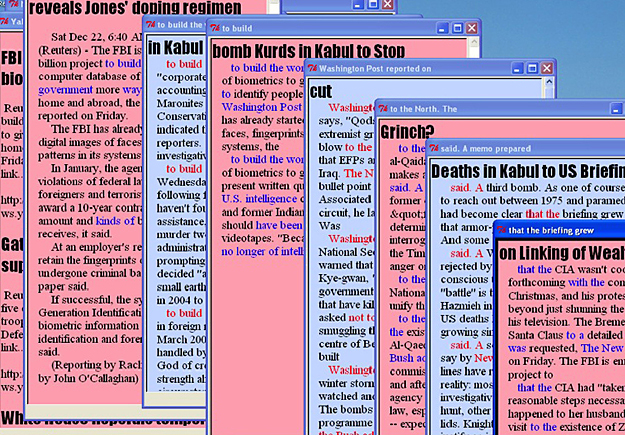
N-gram chains can be followed indefinitely. Each time, the n-grams act as bridges between two separate textual bodies.
But generating nonlinear text strands are just part of the play here; there’s more that can be done.

If you click on a word that’s not highlighted or linked in the alteration text, the chain that extends from that word back to the digram beginning the chain/paragraph will be cut and pasted into the previous document at the point of the digram that led you to this alternative page in the first place. In this example, a click on the word “report” in the first line of the second alteration paragraph causes the phrase “to build a children’s well-being report” to be cut and pasted into the original news article.
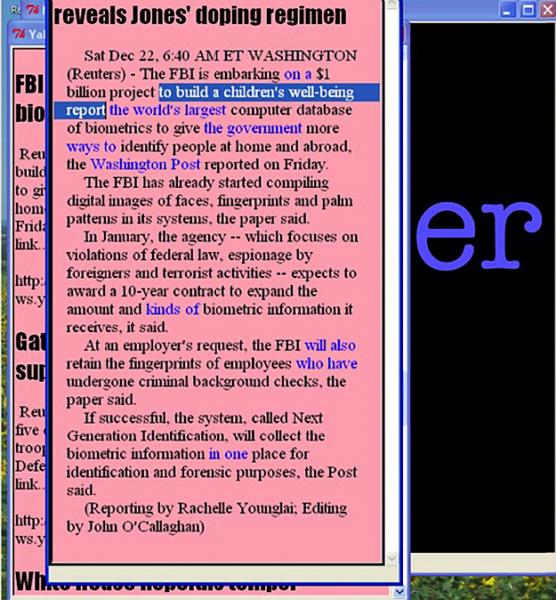
The alteration text screen disappears when this is done, and the phrase “The FBI is embarking on a $1 billion project to build the world’s largest computer database of biometrics” becomes “The FBI is embarking on a $1 billion project to build a children’s well-being report.”

The screenshot above is the result of some extended play with the first paragraph of the article.
The main action of Newsreader seems to be to locate n-grams in a source text (a news feed) and then inject them back in so as to alter that source. But to what end? Could it be argued that this piece is an elaborate machine for creating something that earlier proceduralists like Tristan Tzara and William Burroughs, were able to accomplish with a simple pair of scissors? Or is this program modeling something that goes beyond the syntactic disruptions of an algorithmic cut-up? In order to articulate what’s at stake in a piece like this, I want to do a quick comparison with John Cage’s mesostics — specifically those created for his Norton lectures at Harvard in 1988.
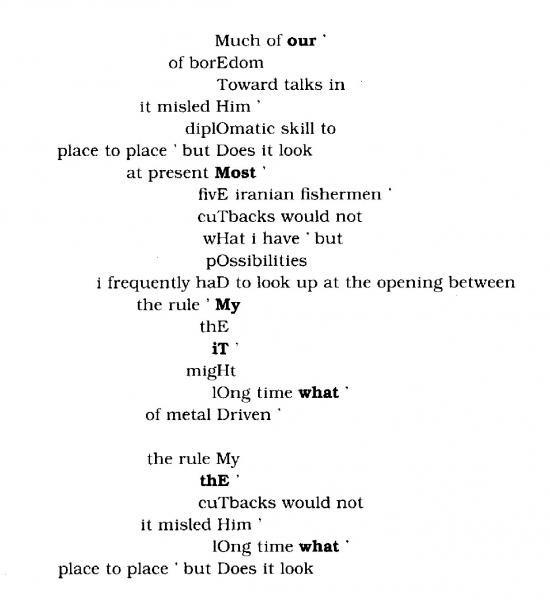
Digitally reproduced by permission of the publisher from I-IV by John Cage, pp. 9, Cambridge, Mass.: Harvard University Press, Copyright © 1990 by the President and Fellows of Harvard College. All rights reserved.
This is the first mesostic strand in the first of the lectures.[2] Very briefly, mesostics are similar to acrostics, but with a center strand functioning as a kind of spine. The center strand is often a name or a group of words (in the excerpt above, it’s the word “method”), used to infiltrate or “read through” a much longer text or group of texts. The mesostic rule requires not repeating two adjacent center string letters which frame the wing words (between the “m” and the “e” in method, there is not a repetition of those letters).
Cage created this procedure so as to make unpredictable discoveries apart from authorial intention. Once the center strand was determined, Cage “hunted” for what the material was trying to say; he looked for the ideas that might become clearer by taking a few words or letters away from the wings. So the words to either side of the center are the result of his editorial choices. As Cage said during one of the question and answer sessions that followed each lecture, “this is a way of writing that comes from ideas but is not about them but somehow brings new ideas or other ideas into existence” (338).
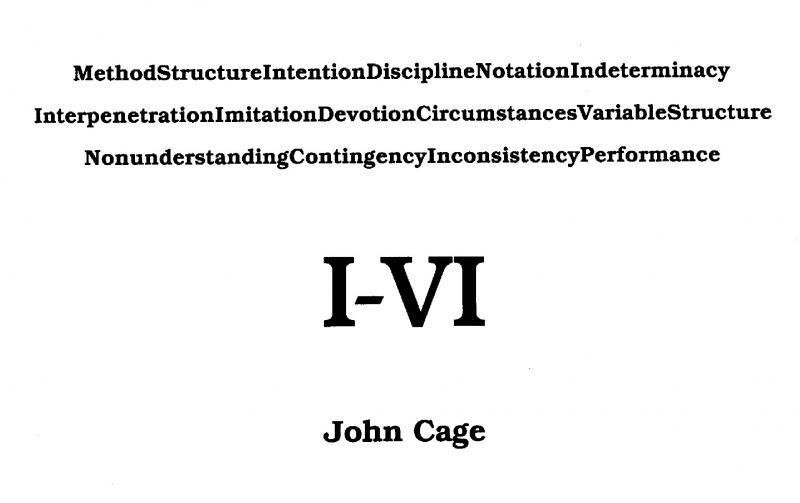
The six Norton lectures are published as I–VI, but the sub- (or super-) title is above. Each word listed refers to an aspect of Cage’s work in music composition, and each word is used as a determining center strand (in the listed order) for sections of the mesostics that make up the lectures. The main reason I’ve chosen this particular procedural work for comparison with Newsreader has to do with Cage’s choice of source texts. Unlike other mesostic works that were generated from singular texts (Joyce’s Finnegans Wake or Thoreau’s journals being well-known examples), these lectures mix writings by a familiar set of Cagean influences (Wittgenstein, Thoreau, Emerson, McLuhan, Buckminster Fuller) with an array of newspaper sources (the New York Times, the Wall Street Journal, and the Christian Science Monitor). Such use of quotidian materials is rare for Cage. Below is a page where the news is visible, if not entirely readable:[3]
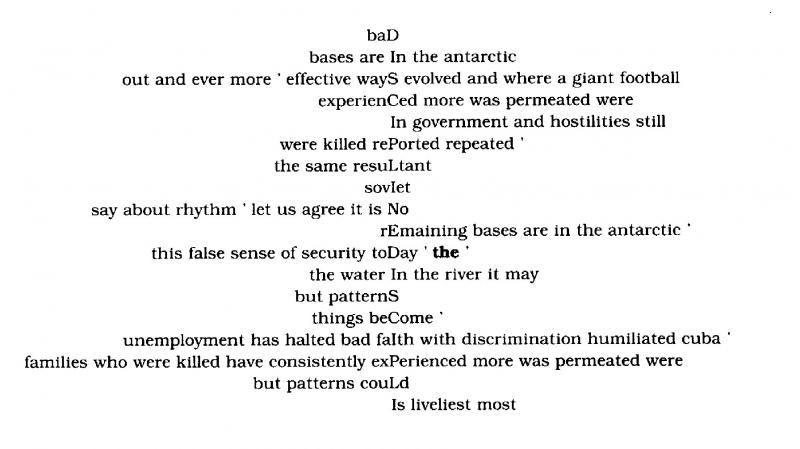
Digitally reproduced by permission of the publisher from I-IV by John Cage, pp. 14, Cambridge, Mass.: Harvard University Press, Copyright © 1990 by the President and Fellows of Harvard College. All rights reserved.
Due to the newspaper text, a number of questions were raised after the lectures about how Cage saw language and politics to be relating in his work. He answered:
I seem to be at a point where maybe many of us are where there’s a kind of separation between us and language and even things that are reported so that we don’t always respond — it’s almost as though we can’t … I’m in a situation of using words so to speak in a straitjacket but a straitjacket that includes the things from which we have so to speak numbed ourselves. I would like to know something more intelligent to say but I don’t know it. (115)
In a later question and answer session he noted, “Performance of a piece of music can be a metaphor of society … you can think of music as a representation of a society in which you would be willing to live” (177). A clue to how this might work is given in Cage’s introduction to I–VI: “there was a tendency on the part of the empty words, the particles, connectives like ‘and’ and ‘the’ and ‘a’ … to become important and to give us a kind of meaning that I’m not sure we fully understand” (5).
In this excerpt from I–IV, we can see and hear the particles:
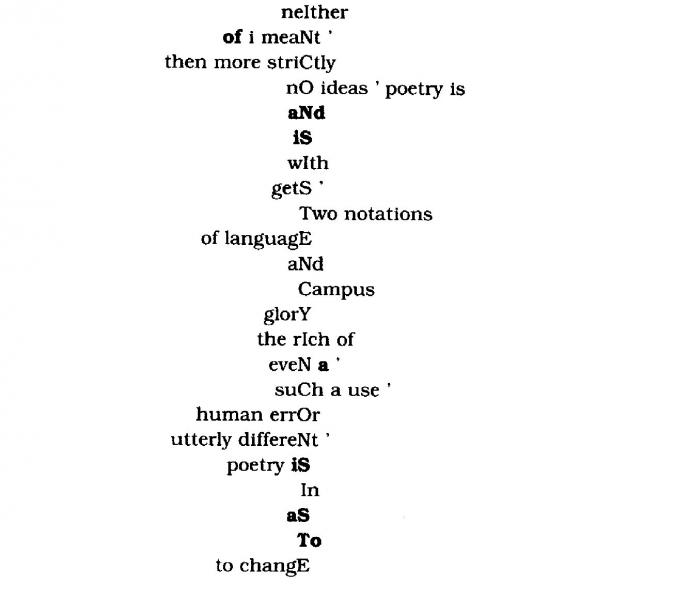
Digitally reproduced by permission of the publisher from I-IV by John Cage, pp. 409, Cambridge, Mass.: Harvard University Press, Copyright © 1990 by the President and Fellows of Harvard College. All rights reserved.
AND IS with gets, is in AS TO …
In relation to this phenomenon, Cage states that “the words that we thought were so meaningful become almost meaningless …. Benefits can come from taking the lesser of two things and supporting it rather than the stronger one, as for instance noise as opposed to musical sound and in this case empty words as opposed to full words and in the case of our society the poor instead of the rich” (254).
Thus the mesostic provides a possible world model, a vision for how the status quo might be altered through a procedural and documentary poetics. Which brings me back to Newsreader. If Cage’s mesostic procedures are modeling a society in which we would be willing to live, what kind of connectivity between text, procedure, and world does Newsreader posit?
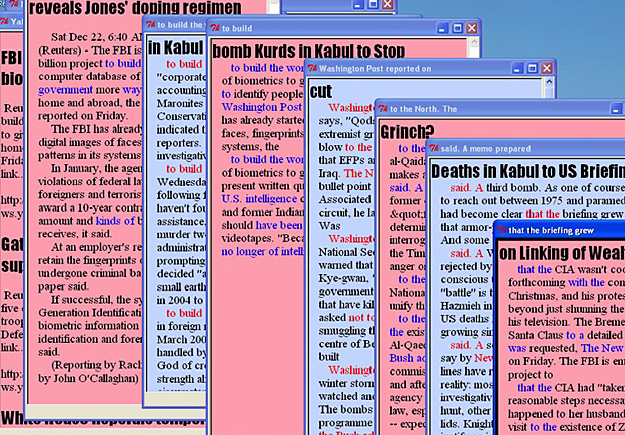
In my exchange with Noah Wardrip-Fruin, it was made clear that the n-gram model that runs Newsreader is used in a number of everyday circumstances, as computers try to recognize and work with the input we give them. For example, in voice recognition software, if a computer was trying to parse out whether a speaker said “banana” or “bandanna,” the trigram “ate the banana” is much more common than “ate the bandanna” and the computer can make its choice based on that knowledge.[4] But the n-gram model is also behind ideas such as “total information awareness” and other government-sponsored mass surveillance projects. These models are used to determine patterns of “normal” language behavior, so as to be able to locate when patterns are transgressed. They are used to locate syntactic combinations that statistically indicate suspicious or criminal behaviors. If you were following your non-linear aesthetic inclinations and found yourself producing digrams and trigrams with unfortunate associations over the Internet or over the phone, this could have consequences if you live in a society where your government decides to eavesdrop on its citizens. You might find yourself in a suspect data set, caught in the net of an early-warning system, marked by your avant-garde word chains. Although this might sound like some kind of Minority Report cyber conspiracy theory, the fact is that datamining for “pre-crime” has been (and no doubt still is) a subject of funded governmental research.[5]
Of course, the total information awareness model can’t actually function. It yields a lot of false negatives and false positives. You can really only get good results for matches on a very small scale — for example, if you’re dealing with textual units, you’ll be more successful trying to find matches for three words than for full sentences. But there are instances when such models do work in more common circumstances — for instance, when Amazon makes suggestions for books you might enjoy, or when a music or film site suggests things based on your past interests. The example that is perhaps most useful because of the potential for negative consequences is when credit card companies use the n-gram algorithm to identify fraud. Credit card companies have defined a profile of purchasing (purchases being the n-grams here) for each individual that can help indicate criminal activity on a card. You may have taken a trip abroad without informing your credit card company and then had the awkward experience, like I once did, of having your card denied at a restaurant. Basically, I was the victim of a false positive in the statistical model that the company used. The inconvenience was annoying, but a relatively small price to pay for the failure, and fairly easy to fix. But the cost for using these models for something like terrorist surveillance is much higher, in that everyone is monitored, everyone is treated as a suspect, and there are perhaps one billion false positives for every one terrorist communication actually intercepted.
According to Wardrip-Fruin, the people designing these surveillance systems know that the costs of massive information aggregation and analysis far outweigh the benefits. But they also know that the model is quite seductive, with its proposition that everything can be accessible and knowable via computer systems (the biometrics article in the Newsreader example above is another instance of that seductive quality). Such a promise is easy to sell to a government that continues to wage war on an abstraction like “terror.” The threat of a “false positive” was clearly not a concern when the 2012 National Defense Authorization Act was passed.
And that’s where Newsreader comes in. It’s a piece that calls attention to use patterns, but emphasizes the fallibility of any attempt to interpret them. It highlights and celebrates the fact that the matches it produces are false positives — they can’t lead to a place of narrative coherence, to a singular meaning. They have a different kind of story to tell, and they evoke meaning in a different kind of way. They defy the concept of normative language structures and predictable usage patterns. The reader must hunt for what these digrams have in common, what they might coincidentally suggest, in the way that Cage hunted through the debris of his procedures’ output for ideas. The action is not of solving a cryptogram, but of reveling in the multiplicitous actions of our words.
Both Newsreader and Cage’s mesostics make use of what we now easily recognize as forms of data mining. Both argue against habitual systems of knowing and experiencing the world, with the help of aleatory and anti-digestive fragmenting procedures. Both show readership (and authorship) to be performative: an act of sampling, transforming, altering, and physically handling text. But perhaps most importantly, both are functioning on metatextual or metaphorical levels, allegorizing our methods of attention, our methods of processing information, and the ways those forms of processing mirror the forms of life we actually live in and with.
As much as I want to make the case that these procedures are two parts of a continuing project, the differences between them keep me from bringing this piece to a tidy conclusion. These documentary procedures are responding to forms and structures that perform the contents of very different historical moments. Cage, in his decision to follow the path of nonintention, was resisting what he saw as the automatic privileging of romantic self-expression and intention. Newsreader, built with an architecture of information processing tools, resists the contemporary desire for everything to be knowable, searchable, and analyzable.
Similar to the Surveillance Camera Players performance group, Newsreader is co-opting a nefarious system and retooling it for creative play. Unlike Cage’s mesostics, which are wonderfully elegant in their precision and thus poised for instigating meditative discoveries through reading or listening, Newsreader’s outputs are deliberately clumsy. Readers are forced to prioritize the concept behind those outputs over the textual product. Readers are asked to see process as the content of the work.
John Cage is often quoted as saying that “the function of art is to imitate Nature in her manner of operation.”[6] Newsreader revises that dictum by declaring that the function of art is to imitate culture and its procedural operations, and that when those cultural operations become dangerously reductive, they must be altered.
1. When I attempted to access Newsreader in order to update my “play” with current news stories, I discovered that it was no longer functional. The creators say that an upgrade may be forthcoming; however, its current dysfunction points to the ephemerality of digital art that relies on an external data source. This piece is built on a certain kind of data collection (of news, in this case) in a particular format. But formats are always changing; perhaps digital works will one day be able to accommodate that constant change. Until then, they function (to use Wardrip’s term) as “impermanence agents.”
2. John Cage, I–VI (Hanover and London: Wesleyan University Press, 1997), 9.
4. Since presenting this talk in 2007, the concept of “n-grams” has moved perhaps more visibly into the mainstream with the introduction of Google’s Ngram viewer.
5. The Total Information Awareness program was created in 2003 as part of the Homeland Security Act. Although it was defunded by Congress in 2004, its work was renamed and absorbed by other intelligence agencies, such as the Disruptive Technology Office and the National Security Branch Analysis Center.
6. John Cage, A Year from Monday (Hanover and London: Wesleyan University Press, 1967), 31.